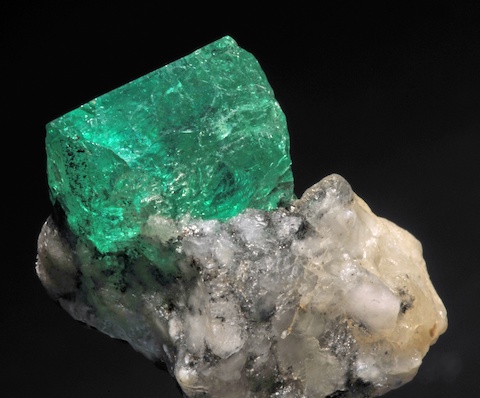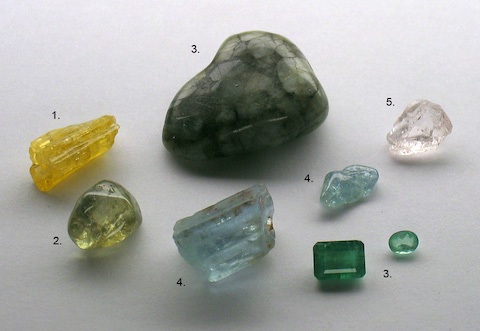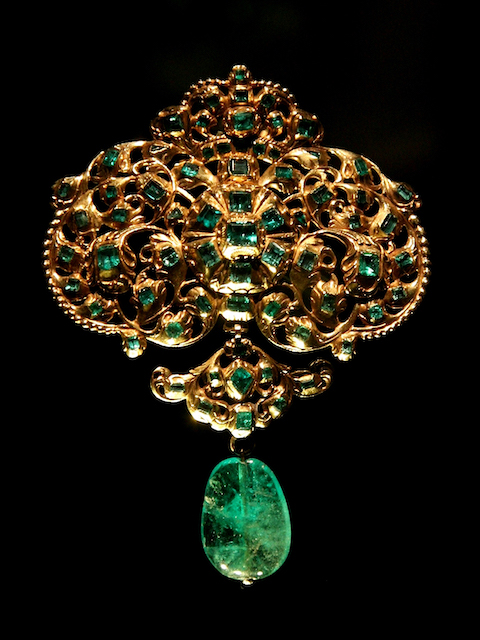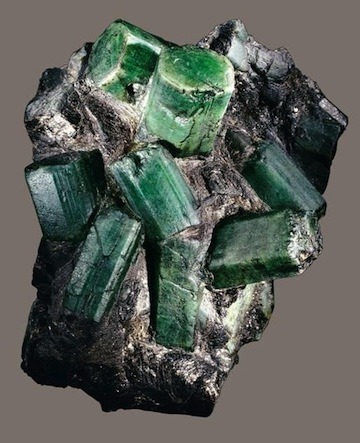
Today, emeralds may be a bit less famous than their red, white, and blue cousins—diamonds, rubies, and sapphires. But they were once perhaps the most celebrated gemstone.
3,500 years ago, the Egyptians found emerald deposits in their kingdom. They ascribed to the stones many mystical properties.
They were symbols of fertility and immortality, perhaps because of their “ever green” color. They were thought to increase eloquence and intuition. Some even thought they could cure malaria.
Those who put emeralds under their tongue could supposedly see into the future.
Perhaps for these reasons, Cleopatra was a big fan, as were other celebrities of her era, like Alexander the Great.
Stars of a more recent time, like Elizabeth Taylor, also loved emeralds, but probably more for their rare color.
And it is quite rare. Emeralds can only form when two scarce elements, beryllium and chromium, happen to occur in the same place in sufficient quantities.
The resulting crystal, more accurately called “green beryl,” is not quite as hard as diamonds, sapphires, or rubies.
Though rare, in the last few centuries we’ve found deposits in other countries, with Colombia producing the greenest stones.
The largest emeralds ever found—nine staggering crystals the diameter of your forearm—sit in a vault in the LA County Sheriff’s office.
These uncut stones, worth nearly 400 million dollars, are surrounded by intrigue, a story perhaps we’ll cover on another EarthDate.
Background
Synopsis: In his first-century AD work, Natural History, Pliny the Elder described emeralds by saying “nothing greens greener.” These vivid gems were a favorite of Cleopatra’s and were mined in Egypt as early as 1500 BC. They are made of a combination of rare elements that rarely occur in the same location, but when conditions are right, some can grow to the size of your forearm.
- In folklore, emeralds were believed to have special powers.
- When placed under the tongue, emeralds supposedly enabled individuals to see into the future. They were symbols of fertility and immortality.
- Emeralds were thought to boost intuition and eloquence while protecting the wearer against evil spells and memory loss. They were even believed to be a cure for cholera and malaria.
- Ancient gem cutters used the soft green of emeralds to relieve eye strain after hours of close work.
- Emerald is one of the four precious gemstones, along with diamond, ruby, and sapphire.
- Diamonds (pure carbon) are the hardest mineral, rating a 10 on the Mohs scale of hardness; rubies and sapphires are varieties of corundum (aluminum oxide) with a hardness of 9. Emeralds are a type of beryl (beryllium aluminosilicate) with a hardness of 7.5 to 8.
- Emeralds are less dense than diamonds, so a 1-carat emerald is larger than 1-carat diamond.
- Emeralds usually have inclusions or fractures and are prone to chipping and cracking, so they should be considered a fragile stone.
- Emerald is a deep-green variety of beryl that gets its color from trace amounts of chromium and vanadium.
- Pure beryl has a composition of Be3Al2(SiO3)6 and is known as “goshenite,” which is clear. Tiny variations in the type and relative amounts of impurities can have a big impact on the mineral’s color.
- Purists may limit the term “emerald” to beryl with trace amounts of chromium, calling beryl with vanadium impurities “green beryl” instead. Some emeralds include both elements.
- Reduced iron creates the light-bluish-green color of aquamarine gemstones.
- Golden beryl and yellow-green heliodor varieties of beryl are caused by varying amounts of oxidized iron.
- The subtle pink color of morganite beryl is caused by traces of manganese.

- Beryllium is rare in Earth’s crust, and finding it near where chromium and vanadium occur is even more unusual.
- The earliest-known emerald mines dated from 1500 BC in Egypt. These mines no longer produce any high-quality emeralds.
- Most emeralds come from Colombia, followed by Brazil, Zambia, and Zimbabwe. Minor amounts come from Madagascar, Nigeria, Ethiopia, Afghanistan, Pakistan, Canada, and Russia.
- The famous chromium-rich emeralds of Colombia are found within black organic shales and carbonaceous limestones that are believed to be the source of the chromium, with hydrothermal fluids percolating through the beryllium-bearing sediments.
- In other regions, emeralds are found in pegmatites or metamorphic contact aureoles where beryllium comes from granitic magma and chromium or vanadium comes from nearby carbonaceous schist or gneiss.
- Unlike gold or other stronger stones and minerals, emeralds do not form sedimentary placer deposits because they are too brittle to withstand much transport. Their specific gravity is also similar to that of quartz and feldspar, cutting down on emerald’s ability to be concentrated in streambeds.
- While synthetic rubies and sapphires were first created in 1907, it took until 1935 for emeralds to be grown in a lab. The Smithsonian now displays the first lab-created emerald, named after its creator, Carroll Chatham.
- Emeralds have been revered by royalty and celebrities for centuries.
- Cleopatra wore emerald jewelry, as did Alexander the Great and Ptolemy.
- The Inca used emeralds in their religious ceremonies starting around the 1200s.
- Royal Indian turbans were decorated with them, and Mughal emperors ate from golden tableware decorated with them.
- Spanish explorers brought emeralds to Europe as part of their New World plunder in the 1700s.
- Queen Elizabeth II, Marlene Dietrich, Grace Kelly, and Elizabeth Taylor are known for their emerald jewelry.
- Emerald is the birthstone for people born in May, reflecting the new green growth of spring.

- One of the largest emerald specimens ever mined, the Bahia Emerald, has been at the center of a crazy tale of intrigue since it was discovered.
- It was unearthed in 2001 in the state of Bahia, Brazil.
- It is a 752-lb (341-kg) chunk of black schist around 3 ft (0.9 m) wide with nine large emeralds sticking out of it, each about the diameter of your forearm. The whole thing is about the size of a minifridge.
- In a mind-boggling, fantastic story that involves panthers attacking mules that were transporting the stone from the mine, countless miners, investors, secretive international flights, Hurricane Katrina, Ponzi schemes, Las Vegas, and maybe even the mob, the Los Angeles Sheriff’s Department finally seized the specimen in 2008 in an attempt to establish the emerald’s owner.
- The case has been in the courts since 2010. So far, 10 people and 3 corporations have claimed ownership, while Brazil has also laid claim to it, declaring it a national treasure that was illegally smuggled out of the country.
- For now, the huge rock, estimated to be worth between a few dollars and $925 million, simply sits in a vault in the LA Sheriff’s Department.


